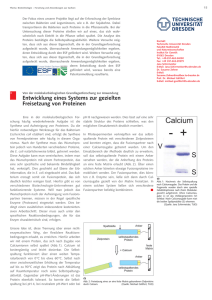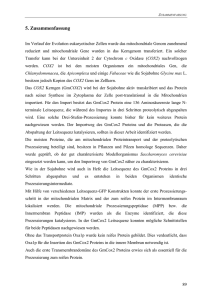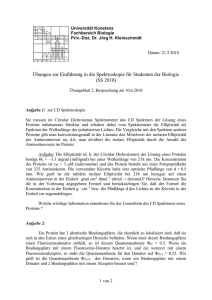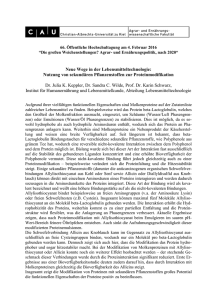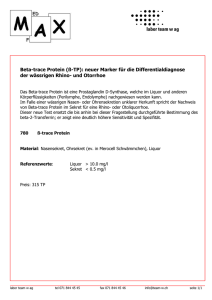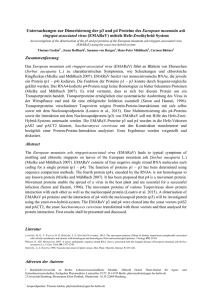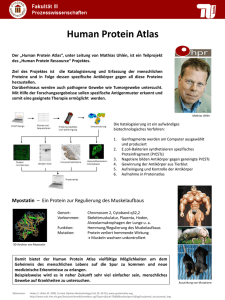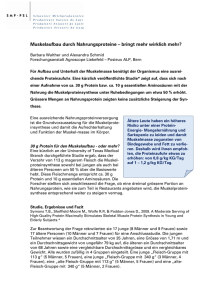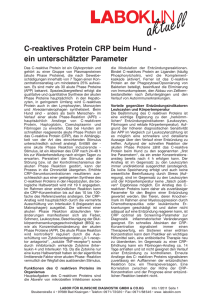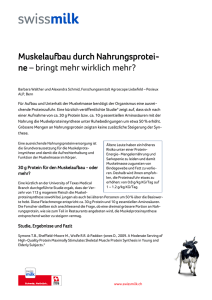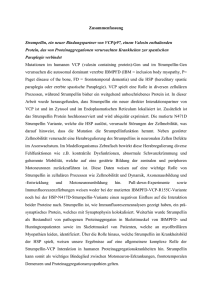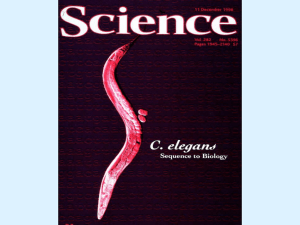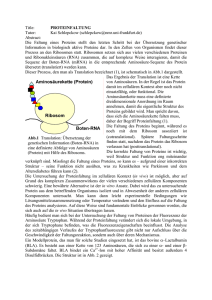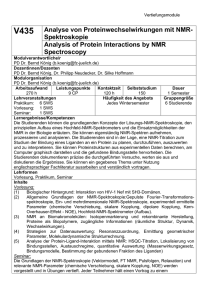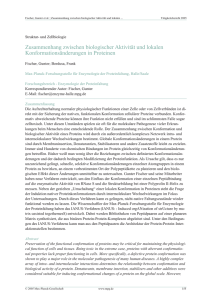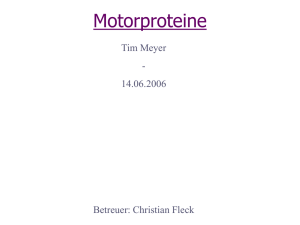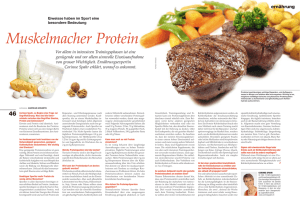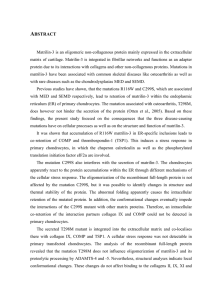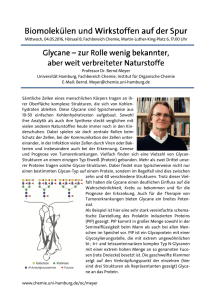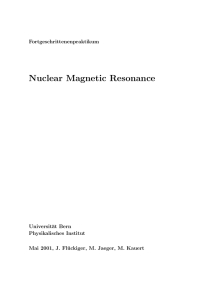ExploringStructural Plasticityin MembraneProteins - ETH E
Werbung
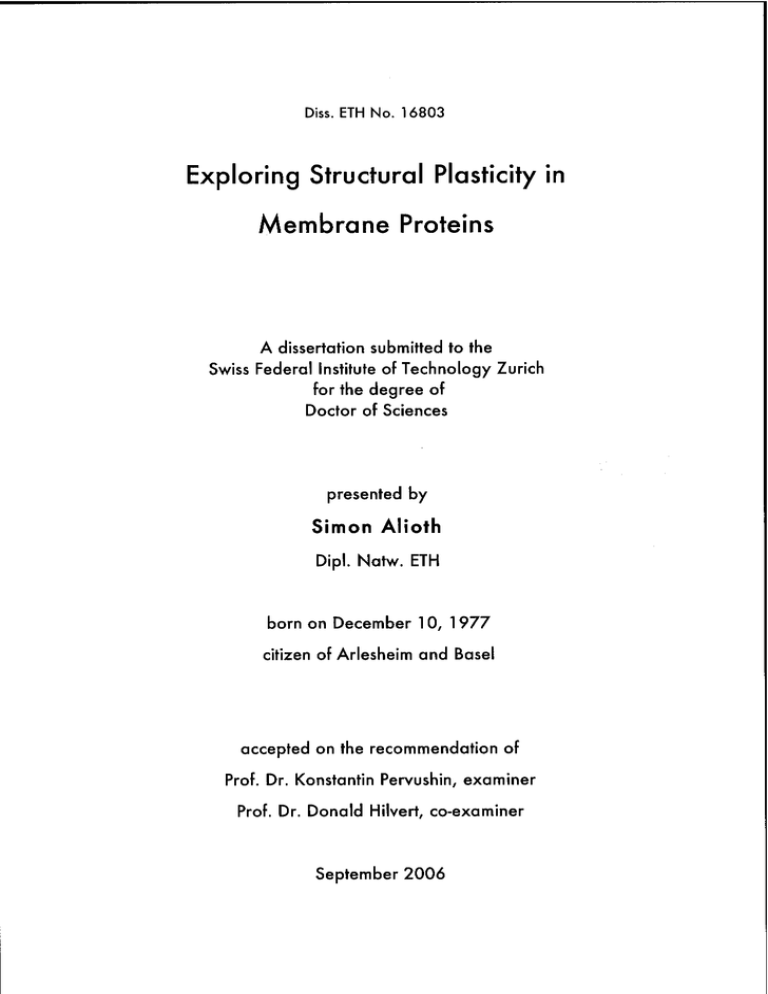
Diss. ETH No. 16803 Exploring Structural Plasticity in Membrane Proteins A dissertation submitted to the Swiss Federal Institute of Technology Zürich for the degree of Doctor of Sciences presented by Simon Alioth Dipl. Natw. ETH born on December 10, 1977 Citizen of Ariesheim and Basel accepted on the recommendation of Prof. Dr. Konstantin Pervushin, examiner Prof. Dr. Donald Hilvert, co-examiner September 2006 ZusflmmcnFnssunG Zusammenfassung In "exploring structural plasticity in membrane proteins" stelle Studien mit drei verschiedenen Membranproteinenvor. Zwei meiner Dissertation ich flüssig NMR der strukturellen Plastizität sind betrachtet, namentlich die Toleranz der tertiär Struktur für die Einfügung und Entfernung von Aminosäuren Gesichtspunkten Aminosäurewindungen("loops"), und die interne Dynamik von Proteinen verursacht durch die physikalische Bewegung von Atomen oder ganzen Atomgruppen. Die strukturelle Plastizität der tertiären Struktur bei der Einfügung und Entfernung oder sogar langen wurde Aminosäuren von (BBP) zu künstlich einem entwickeltem beta-barrel Aminosäurewindungenvom "outer membrane coli würden gekürzt um eine minimale beta-barrel gewinnen, welche aus dem tansmembranen Teil von OmpA Membranprotein untersucht. protein A" (OmpA) von E. Plattform an Alle Aminosäure-Sequenzen. Die tertiäre Struktur dieses wurde mit flüssig NMR aufgeklärt um die strukturelle Konsequenz besteht verbunden durch kurze neuen Proteins erforschen. BBP wurde Entfernung von Aminosäuren zusätzlich verwendet für die Entwicklung eines beta-barrel Proteins, welches in der Lage ist, Metalionen zu binden. Dies wurde erreicht durch die Einführung eines von Einfügung und zu "EF-hand" Ca2+-Bindungselements. Diese das Protein, durch Metalbindungsstelle wurde verwendet um die Titration mit paramagnetischen Ionen, im magnetischen Feld schwach auszurichten. Dies ermöglicht die Detektion von Schlussendlich wurde BBP verwendet, um die interne beta-barrel Membranproteinen genauer zu untersuchen. couplings". Die interne Dynamik von Membranproteinen dipolar Dynamik von "residual wurde zusätzlich im Detail untersucht alpha-helikalen in der Membrane verankertem Enzym Alkanhydroxylase (AlkB) von Pseudomonas oleoverans und der cytoplasmatischen Domäne des CIC-O an dem Chloridkanals von Torpedo marmorafa. ZusnmiMnmssmiG Monooxygenase, welche in der aktiven Tasche zwei Eisenatome an Histidinreste koordiniert. Ermöglicht durch eine neue Expressions-, Markierungs- und Reinigungsmethode werden die ersten flüssig NMR Resultate von diesem 46 kDa alpha-helikalen Membranprotein vorgestellt. Zusätzlich wurde die strukturelle Plastizität in Abhängigkeit des Redox-Zustandsvon Eisen mit NMR und EPR Spektroskopie untersucht. AlkB ist eine nicht-Häm Mit Röntgen-Kristallographlewurde entdeckt, dass des CIC-O Chloridkanals zwei lange cytoplasmatischen Domäne intrinsisch unstrukturierte Elemente in der Struktur enthält. Die meisten Aminosäuren von diesen flexiblen Teilen konnten Spektra zugeordnet werden. Auf der Basis von 15N-Relaxation wurde die interne Dynamik des Proteins im Detail untersucht. Die Resultate von dynamischen Messungen und "residual dipolar couplings" deuten darauf hin, dass es Neigungen zur Strukturbildung in diesen sonst unstrukturierten Proteinfragmenten gibt. Die Entdeckung von verbleibendenstrukturellen Elementen Resonanzen in den flüssig die NMR in der cytoplasmatischen Domäne des CIC-O Chloridkanals ist ein grosser Fortschritt im Verständnis der Funktion von dieser Proteindomäne. SußimHRV Summary In my thesis "exploring structural plasticity in membrane proteins" Solution NMR studies of three different membrane proteins. Structural explored from two different aspects, namely, insertion or deletion of amino aeids or even I present plasticity is the tolerance of tertiary structures to long loops and internal dynamics of proteins caused by physical movement of atoms or groups of atoms. The tolerance of tertiary strueture to insertions and deletions of amino aeids was artificially engineered beta-barrel membrane protein. All loops from the outer membrane protein A (OmpA) from E. co/i were truncated to obtain a minimal beta-barrel platform (BBP) consisting of the transmenbrane part of OmpA with short connecting turns. BBP was used to engineer a beta-barrel protein with the ability to bind metal ions by inserting an EF-hand Ca2+-binding loop. The tertiary strueture of this new membrane protein was elueidated by Solution NMR spectroscopyto study structural consequences of deletion and insertions of loops. The metal binding loop was used to weakly align the protein in the magnetic field by titrating the protein with paramagnetic ions, which opened a possibility for detection of residual dipolar couplings.Finally, BBP was used to investigate internal dynamics of beta-barrelmembrane proteins. studied using an additionallystudied in detail with the alpha helical membrane embedded enzyme alkane hydroxylase (AlkB) from Pseudomonas oleoverans and the cytoplasmatic domain of the ClC-0 chloride channel from Torpedo marmorafa. Internal dynamics of membrane proteins are non-heme monooxygenase containing two iron atoms coordinated to histidine residues in the active site. The first Solution NMR spectroscopy results from AlkB is a integral this 46 kDa alpha micelles presented, enabled by are helical protein solubilized in detergent expression, labeling and purification membrane a new SummoRV method. In addition, structural plasticity depending on the redox state of the diiron cluster was investigatedby NMR and EPR spectroscopy. cytoplasmatic domain of the CIC-O chloride channel contains two long intrinsically disordered elements in the strueture, as established by X-ray crystallog raphy. Most of the amino aeids in the flexible part of the protein could be assigned to resonances in the Solution NMR spectra. On the basis of 15N-relaxation data the internal dynamics of the protein were studied in detail. Results from dynamics and residual dipolar couplings indicated the presence of structural propensities in this otherwise disordered protein fragments. The discovery of residual strueture in the cytroplasmatic domain of CIC-O domain is a major step forward in understanding the function of this protein. The
